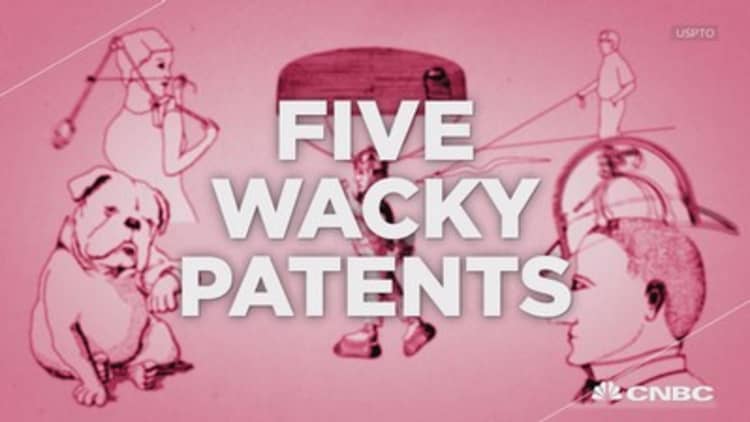
Tech giants such as IBM, Samsung and Apple received thousands of patents each year, with many going by the wayside. That means it's hard out there for individual inventors, even if they received patents for what would otherwise be eccentric devices.
Here's a glance at some of the weirdest patent filings at U.S. Patent and Trademark Office. Take Benjamin Oppenheimer, for example. In 1879, the inventor received a patent for what he thought was a potentially life-saving device for humans.
Oppenheimer's fire escape system consisted of a parachute that could be attached to the head "… by which a person may safely jump out of the window of a burning building from any height and land without injury…," according to Oppenheimer's patent application, filed with the U.S. Patent and Trademark Office more than a century ago.
Oppenheimer faced stiff odds back then, and not much has changed. Every year for the past 10 years, hundreds of thousands of applications were filed with the government agency. And every year, only around half of applicants are granted a patent.
A total of 618,330 patent applications were submitted by inventors last year, and 329,613 of those inventions received patents, according to the U.S.P.T.O.
The odds of obtaining a patent in the 1980s were more favorable but still far from guaranteed.
In 1989, 165,748 patent applications were filed and 102,533 were granted.
That September, Rodney Metts and Thomas Barry applied for a patent on a timekeeping device that could keep time at a different rate, according to the patent application. For example, the clock would allow dog owners to be able to keep time in the equivalent of so-called dog years, which would amount to seven years for humans.
"The display would preferably show the standard 12-hour analog display with the hands revolving, say, seven times faster for dog time so that seven 'dog days' would elapse in the time it takes for one 'human day,' " according to the patent application, which was granted.
Another strange-but-true patent? Check out the "self-congratulatory apparatus."
"The hand is manually swingable into and out of contact with the user's back to give an amusing or an important pat-on-the-back," explained the patent application, granted in 1986.
"In the absence of other persons or of persons either friendly or sensitive to one's needs, the individual must resort to raising their arm and hand high into the air overhead and bending the arm at the elbow to allow the hand to gently strike the upper portion of the back," according to the application filed by Ralph Piro, the gadget's inventor.
"This places one in a somewhat uncomfortable posture and additionally lacks the placement of a pat in the most desired middle portion of the back," according to the document.
'Make Me a Millionaire Inventor' premiered on Wednesday, Aug. 15, 2015, at 10 p.m. ET/PT on CNBC. Tune in on Wednesdays.




